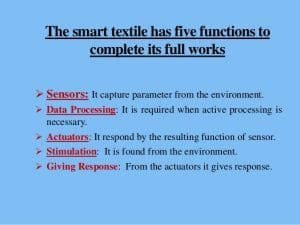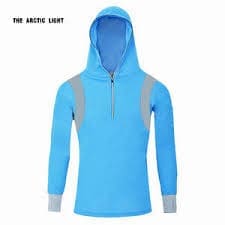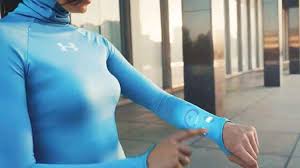Clothing is considered as one of the three basic human needs. From the prehistoric age, textiles are used for clothing then extended to household and domestic purpose with developing civilization. The earlier textile was used in different forms such as tents, protective garments, ropes, etc. used for technical performance.
Textile is an article made by weaving threads or yarn into fabric. Initially, these were made of natural animal or plant-based fibres. Later with improvement in technology synthetic fibres were designed in laboratories which feature versatility and were strong.
In this day and age, digital technologies have reached to the benchmark were extremely thin fibres that run through the smartphone and wired data can be woven into clothes textiles. That’s what a Smart Textiles really is.
The word smart textiles were acquired from intelligent or smart materials. The term smart materials were defined for the first time in Japan in 1989. Smart Textiles can be defined as the textiles with an ability to sense the stimulus from the environment, react to them and can adapt themselves for the integration of functionalities in the textile structure. Stimulus and response can have electrical, thermal, chemical, magnetic, or other origins.
Smart textiles are now unified with the service ecosystem that can go beyond the current scenario of the textile value chain. Smart Textiles also have an ability to interact with wearer’s body and to sense the wearer’s physiology and respond to his needs. Smart textile will soon have an intangible property from service with an ability to measure and store data and change the functionality over time. These technologies have paved the path for an alliance between the textile developers and the service providers to work together and develop these types of smart textile services (STSs). Collaboration between the textile developers and service providers will offer a huge range of opportunities for the textile developers, product designers, and service designers.
The invention of synthetic fabric Lycra in 1960 is considered as the most commonly used smart fabric due to its unprecedented elasticity in sports and fashion markets. This fabric with its combination with natural fibre is used for making swimwear, hosiery, surgical garments, interior furnishing, clothing which features of elasticity functionality and comfortable to wear.
HOW SMART TEXTILES WORK
All smart materials consist of energy transfer from the stimuli to the response. Smart materials are the integrated and the complex materials which have an ability of processing, analysing, and responding with an adaptation to the environment. This material has the potentiality to change themselves depending on the temperature, pressure, density, or internal energy change. The behaviour of smart material is governed by the amount of energy required and a degree of a specific change. If the material gets energy from the outer environment it tends to resist it or absorb it without changing on it.

TYPES OF SMART TEXTILES
- Passive smart textiles: This is considered to be the first generation smart textile where materials can only sense the environmental conditions. These only perceive the data about the conditions of the environment an act like a sensor which can be accessed by changing its colour shape thermal and electrical resistivity, like a garment with built-in thermistors can log the body temperature over time. Example of passive smart textiles is UV protective clothing, plasma-treated clothing, fabric with Optical Sensors.
- Active Smart textiles: These are considered to be the second generation of smart textile
 that have the property of both sensors and actuators. They can sense and respond to external conditions. If the actuators are attached in the passive smart textiles it will become an active smart textile as it can respond to the particular stimulus. Active smart fabrics are smart fabrics in real terms which features of regulating temperature, absorbing vapours, memorizing shape, resisting water, and having a chameleon effect.
that have the property of both sensors and actuators. They can sense and respond to external conditions. If the actuators are attached in the passive smart textiles it will become an active smart textile as it can respond to the particular stimulus. Active smart fabrics are smart fabrics in real terms which features of regulating temperature, absorbing vapours, memorizing shape, resisting water, and having a chameleon effect. - Ultra smart textiles: These are the third generation of smart textiles with much more
 advanced technology. These are material which can act like sensors receiving the stimuli from the environment, respond to the stimuli and can reshape themselves according to the external conditions. These can make forecast and fit the external conditions along with sensing the data types. They exhibit the functions of the brain owing to microcomputer attached with it. Examples of ultra-smart textiles are spacesuits, sports jackets, musical jackets, wearable computers, etc.
advanced technology. These are material which can act like sensors receiving the stimuli from the environment, respond to the stimuli and can reshape themselves according to the external conditions. These can make forecast and fit the external conditions along with sensing the data types. They exhibit the functions of the brain owing to microcomputer attached with it. Examples of ultra-smart textiles are spacesuits, sports jackets, musical jackets, wearable computers, etc. - Types of smart clothing by items include shoes, scarf, dresses, jacket, shirt, insoles, bicycle helmets, etc.
APPLICATIONS OF SMART TEXTILES
- Healthcare: The development of wearable monitoring technology is having its effect on health care in form of Telemedicine. Integration of high technology with the textiles has an enormous boom for personalized Health Care. Personalized Healthcare facility for an individual to manage and assess its own Health Care needs. Technology embedded clothing helps to monitor chronically ill patients and those undergoing rehabilitation. In medical fields, Europe and USA have achieved few promising results mainly electrocardiogram and respiration monitoring by implementing strain fabric sensors and fabric electrodes. A wireless garment with patch textile sensors can be used to monitor ECG, respiration, EMG, and physical activities.

- Defence: Soldiers on Battlefield survive in extremely hazardous situations and environmental conditions where there is a need for Real-Time Information Technology so as to have increased protection and survivability. This technology-enabled fabric can use to monitor the vital signs and ease injuries simultaneously monitoring the environmental hazards like toxic gases. It can also be used to have strong assistance between emergency response services and defence forces.

- Fashion and Entertainment: Designers are trying to engage their creativity with emerging technology. These clothing also include the clubwear that reacts to the movement of light and body and illuminates when the dancer moves of the clothing. These devices contain the microprocessors, data transmissions and the power supplies.

- Sportswear: Initially this technology was used in sportswear to monitor the heart rate and the blood pressure during the gym workout or the morning run. The sports industry has embedded integrated fabric sensors and the display panels in the products to analyse the information and give feedback on the performance along with performance-enhancing music.

FUTURE ADVANCEMENTS IN SMART FABRICS
With the increasing popularity of smart textiles, designers and the scientist will the try to push the limits further to have more advancements and development with textiles expanding its capabilities and making them able to function as a second skin. The most significant area to witness the development will be the field of Health Care and Wellness to track the physiological condition of patients with sensors and administer medicines through wearable textiles. Smart textile will have a progression in beauty industry also with a fabric having anti-ageing properties, lotions, and perfumes. With ongoing advancements, it is possible to have the self-healing and repairing fabric in reality.
Further advancements will also include the garments consisting of Lumalive Textiles which are able to transmit message and advertisements. Philips Electronics is planning to design fabric with Lumalive Technology-enabling soft furnishings like curtains and cushions to alter the colour and illuminate subsequently uplifting the mood and atmosphere.
Article Written By-
Naina Rupani, Management Trainee- TVC
FOSTIIMA Business School
navyarupani09@gmail.com

